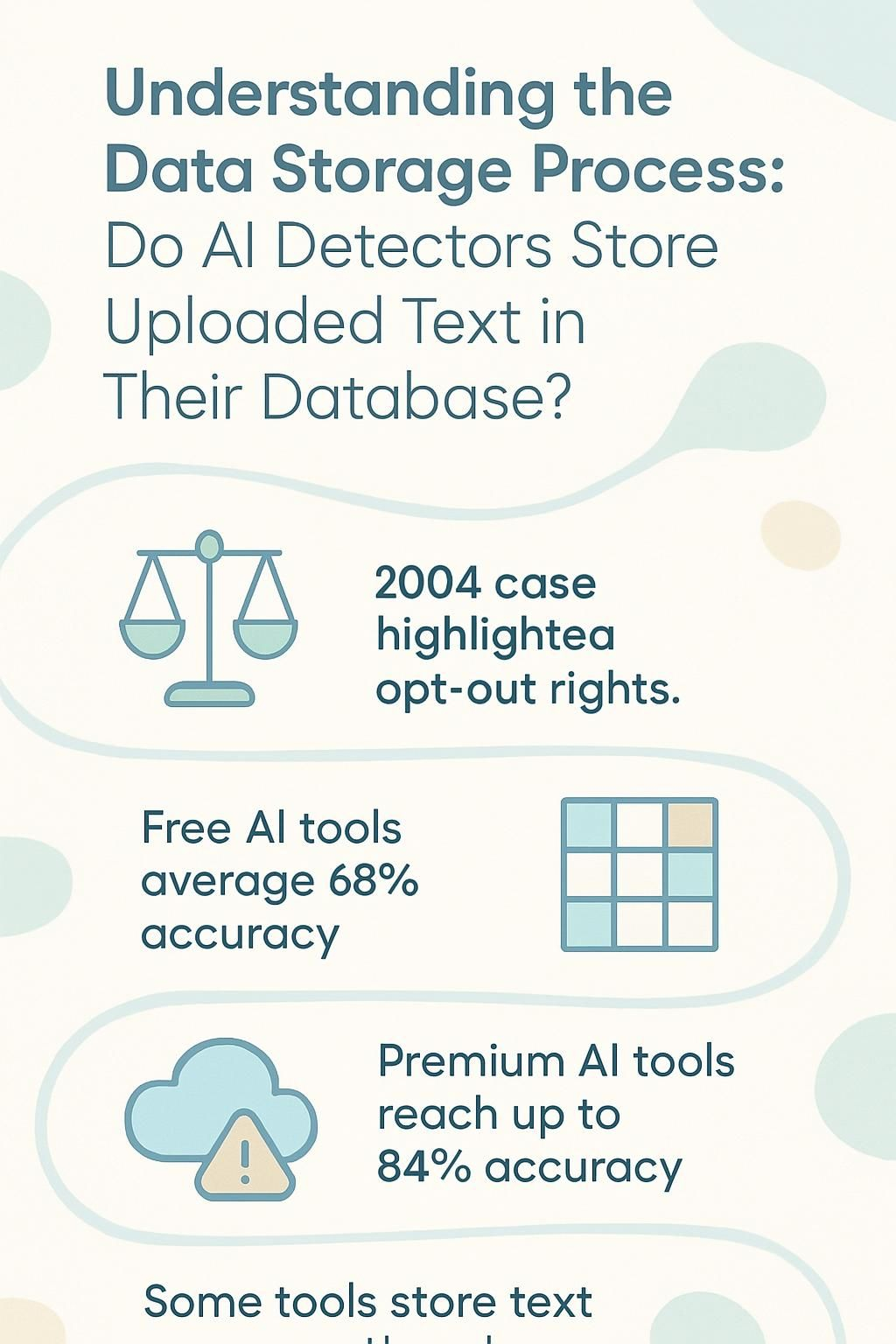Worried about whether AI detectors save your uploaded text in their database? These tools analyze text to spot signs of AI-generated content, like writing from ChatGPT. This blog will explain how they work, if your data is stored, and what privacy risks exist.
Keep reading to stay informed!
Key Takeaways
- AI detectors often store uploaded text temporarily for analysis, but some tools, like Copyleaks, may keep it permanently unless users delete it manually.
- Privacy concerns arise from unauthorized data retention and risks to intellectual property. Tools must comply with laws like the Freedom of Information & Protection of Privacy Act (FIPPA).
- The 2004 Rosenfeld v. McGill case emphasized user rights, including opting out without penalties when sharing sensitive content or student work.
- Many AI detectors have low accuracy rates—free tools average 68%, while premium ones reach up to 84%. OpenAI discontinued its detection tool in 2023 due to poor performance.
- Always review privacy policies and pick tools that state they don’t store data long-term to protect your personal or academic content.

How AI Detectors Process Uploaded Text
AI detectors scan your text using smart algorithms. They work fast, checking patterns and comparing data with large language models.
Key steps in the detection process
AI detectors analyze text to identify if it is human-made or generated by artificial intelligence. They follow a structured process to ensure accuracy and efficient detection.
- Uploading the text: Users input the document into the tool. Text fields or file uploads are often available.
- Text preprocessing: The detector cleans the input. It removes extra spaces, special characters, or irrelevant data.
- Tokenization: The system breaks down sentences into smaller parts called tokens. These could be words or short phrases.
- Perplexity evaluation: The algorithm measures how predictable the text is. AI-generated content often has lower unpredictability compared to human writing.
- Burstiness analysis: The tool checks for sentence variety in length and structure. Humans tend to write with more variation, while AI texts appear uniform.
- Pattern comparison: The system compares processed data against known patterns of AI- and human-created texts using machine learning models like large language models (LLMs).
- Final result generation: After analyzing all factors, the detector provides results showing whether the content is likely written by humans or AI tools like ChatGPT.
This step-by-step approach helps ensure reliability while spotting plagiarism or AI-generated materials effectively.
Use of algorithms and machine learning models
Algorithms break down text into smaller parts. They then analyze patterns, grammar, and style. This helps check if the text matches known human or AI writing styles. Plagiarism detectors rely on these steps to flag AI-generated content accurately.
Machine learning models play a big role in this process too. Models like GPT are trained to spot differences between human-written and AI-generated text by studying data trends over time.
Regular updates make them better at detecting new tricks from generative AI tools like ChatGPT or others using language processing techniques.
Do AI Detectors Store Uploaded Text?
AI detectors often keep text for a short time to check it. Some might save data longer, depending on their rules or settings.
Temporary storage during analysis
Uploaded text often goes into temporary storage during analysis. This step helps AI content detectors, like plagiarism checkers or language models, process data efficiently. The text gets held briefly while algorithms inspect it for plagiarized material or AI-generated content.
Some tools, such as Copyleaks AI detector, keep this temporary data longer unless users delete it manually. While stored temporarily, the system checks originality and flags possible issues with citation styles or self-plagiarism.
Without user action to remove files, the risk of retention grows stronger.
Permanent storage policies
Some AI detectors, like Copyleaks, keep uploaded content unless users delete it. This can raise privacy concerns if people forget to remove their text. Institutions cannot submit student work to these tools without getting permission first.
Violating this rule could lead to legal disputes or penalties.
Users should know they have the right to opt-out of permanent storage policies without facing consequences. For example, Rosenfeld v. McGill in 2004 highlighted this right for individuals when dealing with data-using systems.
Always check a detector’s privacy terms before uploading sensitive information like academic writing or creative projects.
Privacy Concerns with AI Detectors
AI detectors may hold text briefly during checks, raising privacy flags. This can pose risks if sensitive or copyrighted content gets stored without users knowing.
Risks of unauthorized data retention
Unauthorized data retention can expose sensitive information to misuse. AI detectors, like those analyzing plagiarism detection or ai-generated content, may store uploaded texts without permission.
This could violate privacy laws and ethical guidelines. Students’ work, for instance, must not be submitted by instructors without their approval.
Such risks also affect intellectual property. For example, creators uploading original pieces might lose control over how their content is used if stored improperly. Hackers targeting weak systems could exploit this retained data too.
Users should carefully review the terms of services offered by tools like grammar checkers or chatbots to protect themselves from these issues.
Implications for intellectual property
AI detectors can pose risks to intellectual property rights. Uploaded text, whether from students or professionals, may face unauthorized use if stored without proper consent. This violates protections like the Freedom of Information & Protection of Privacy Act (FIPPA).
Institutions cannot share student work without permission under such laws.
The Rosenfeld v. McGill case in 2004 highlighted the right to opt-out without penalties. Creators should be cautious using tools like ChatGPT or originality.ai since unclear storage policies could lead to misuse.
Manual deletion of uploaded text is vital to prevent unapproved retention and reduce these risks.
Transparency in AI Detector Practices
Companies behind AI detectors must be open about how they handle user data. Clear terms and honest policies build trust, making users feel safer.
Terms of service and user consent
Terms of service must clearly explain how AI detectors handle uploaded text. These policies should specify if data gets stored temporarily or permanently. Users deserve to know whether their content is saved after analysis.
Platforms like Originality.ai often highlight storage rules, but not all tools are equally upfront. Legal guidelines stress that users must give consent before their work is processed.
Institutions should allow manual deletion of uploads, offering control over personal files. Some systems provide this option in settings menus or user dashboards for convenience and reassurance.
Failing to disclose retention practices can harm trust and raise privacy concerns about intellectual property misuse. Always skim through these terms to understand risks better before uploading sensitive text online.
Legal guidelines and compliance
Proper legal guidelines protect users’ data and rights. The Freedom of Information & Protection of Privacy Act (FIPPA) safeguards intellectual property. AI detectors must respect this law, barring unauthorized use or storage of submitted text.
Users also have the right to opt out without penalties. In 2004, Rosenfeld v. McGill confirmed that institutions cannot submit student work without their consent. Compliance ensures transparency and accountability for tools like Originality.ai in safeguarding user trust.
Review of AI Detectors
AI detectors often miss the mark. Free tools hit just 68% accuracy, while premium ones manage only up to 84%. The average sits at a shaky 60%, leaving room for doubt. OpenAI’s own tool was scrapped in 2023 due to poor performance.
These detectors can wrongly tag human-written text as AI-generated. Non-native English writers face even more bias, leading to unfair results. Tools like ZeroGPT and WinstonAI conflict in their findings, creating confusion instead of clarity.
For now, these systems remain experimental with big gaps in reliability.
Best Practices for Safe Usage of AI Detectors
Always check the tool’s privacy settings before uploading text, so you know how your data is handled. Opt for AI detectors that clearly state they don’t store content long-term.
Reviewing privacy policies and permissions
Check privacy policies before using AI detectors like Originality.ai or ChatGPT. Some tools may temporarily store text for analysis, but they should delete it after use. Institutions must clearly inform users about data retention rules.
You can also get details on whether uploaded documents stay private or are shared.
Look for options to manually delete files if needed, as not all platforms offer this feature. User consent is key, and trustworthy services always ask first. Next, consider safer alternatives without storage risks when using these tools.
Using alternative tools with no storage risks
Pick tools that don’t keep your data after scanning. Some AI detectors analyze uploads without saving them, lowering privacy risks. For example, free or open-source platforms often avoid storing content to protect user trust.
Always check if the tool mentions temporary storage only during analysis.
Students should get consent before using these tools for essays or homework checks. Instructors must avoid uploading student files without permission too. This helps safeguard creative work and prevents unfair use of personal or academic content.
Conclusion
AI detectors are helpful, but their storage practices raise questions. Some only keep text temporarily for analysis, while others may store it longer. Always check privacy policies before uploading sensitive content.
Stay informed to protect your data and make smarter choices using these tools!
For an in-depth analysis of various AI detectors and how they handle your data, visit our comprehensive review.



